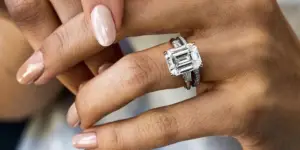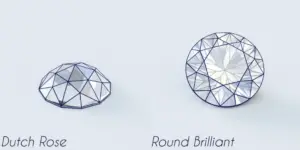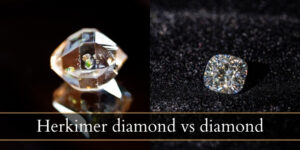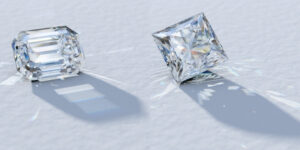Wondering what kind of gems you have at your disposal if you’d like to go for a brown or chocolate-themed jewelry ? Look no more, as we’ll walk you through the most common and easy to source brown gems. There are more brown gems than the ones on this list, but these are the ones you’re most likely to find at a jeweler or carried by a retailer, thus making your life easier.
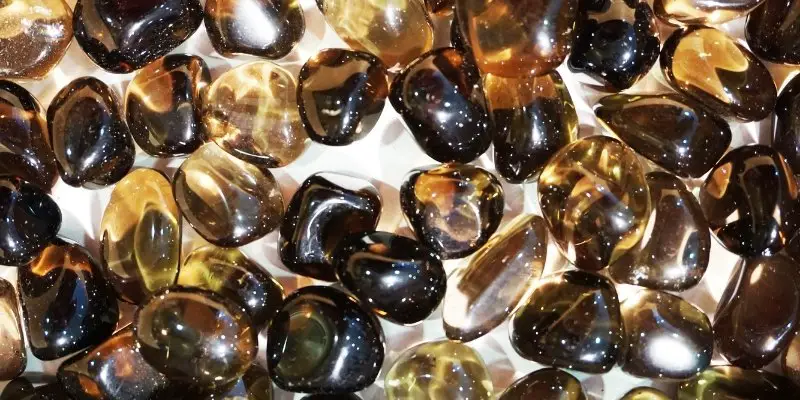
What gemstones are brown ?
The most well known brown gems are chocolate diamonds, smoky quartz, some types of amber, and tiger’s eye. However there are more gems than that, less known but still beautiful, such as brown garnet, brown tourmaline, brown topaz, chocolate opal, and brown citrine.
The many hues of brown can range from red dominant to yellow dominant to nearly black to slightly green, and some of these gems have a bit of color play to them like the chocolate opal. There are so many options you can choose from when it comes to brown gems, but only some of them are transparent or at least translucent. Most of the gems we’ve added to this list are transparent or translucent, but we’ve also added some opaque ones. Now let’s take a look.
1. Chocolate and champagne diamonds
Diamonds come in many colors, but the most common one is a yellow-brown hue. The ones you see for sale are the very top tier diamonds, with as little yellow or brown in them as possible, making them appear clear (or white). However most diamonds do have some color to them, and some of them are truly colorful. Those are classed as fancy color diamonds.
Brown diamonds come under different names, mostly dictated by the intensity of the brown. For example the deeper color ones are usually called chocolate, while the lighter ones are called champagne. They are still brown diamonds, no matter the name.
Color
Brown diamonds range from very pale light brown to dark brown, and they may or may not have slight inclusions. Most brown diamonds have a yellow undertone but some of them can have a bit of a red undertone, resulting in a muddled pink-brown hue or a faded dark, rusty red. Another common undertone is gray, and those usually come in quite a few inclusions in them.
Price
Brown diamonds sell for a much lower price than clear diamonds, or other fancy color diamonds at that. These diamonds tend to be the most affordable. You can find brown diamonds selling for an average of $2,500 per carat for a medium-color gem with no dominant undertone (so just brown) and a bit of an inclusion.
There are also brown diamonds that sell for much more, such as $30,000 per carat if the color is vivid but light, and there are no imperfections within the diamond. Most of the time though you will find the lower end brown diamonds.
Hardness
Brown diamonds score a 10/10 on the Mohs scale so they are perfect for everyday wear in any sort of jewelry you like.
2. Brown garnet
Garnets are red or green most of the time but they can actually go as far as brown ! They’re less common than other garnet colors, but you can still find them at jewelers and retailers. It’s not the most common brown gem though, so you might need some patience when looking for it.
Color
Brown garnets come in various intensities and they may have a red undertone, a yellow undertone, or a mix of the two. Think of brown garnets as the many color of autumn leaves, from rusty brown to deep orange-brown to dark yellow.
Price
Brown garnet sells for an average of $60 per carat for a medium intensity gem with no visible inclusions. The more expensive brown garnets are actually color change garnets, that go from a peachy-orange to brown, or a rusty red to orange, or a greenish brown to rusty orange and so on. Those usually sell for $100 per carat.
Hardness
Garnets average a 7 on the Mohs scale, which makes them just barely acceptable for daily wear. These are not soft gems by any means, but they can and will pick up scratches as the years go by, and they will require regular polishing to keep their luster.
Read also: Do Diamonds Last Forever ?
3. Brown tourmaline
Tourmaline comes in many, many colors but the most well known ones are green and pink. However brown tourmaline is also possible, even if it’s not as well known as the other two colors. That being said, it’s still possible to find these but you might not find ready-made jewelry with brown tourmaline, only loose stones.
Color
Brown tourmaline tend to have a yellow undertone, resulting in a golden-brown or honey brown color. There are light colors as well, but this gem tends to be vivid most of the time. A slight green undertone is sometimes possible.
Price
Brown tourmaline sells for an average of $70 per carat, for a vivid color brown with few discernible inclusions (VVS2).
Hardness
Tourmaline ranks just like garnet on the Mohs scale, an average of 7/10 which makes this a gemstone that could potentially be worn everyday but should still be take off before doing any strenuous activity. or, set in a pair of earrings, a brooch, or a pendant that will keep tourmaline much safer than a ring or bracelet.
4. Chocolate opal
Chocolate opal sounds delicious but it is, sadly, not made of actual chocolate. This is a type of opal similar to fire opal, in that it does not have much play of color, but when it does it’s in the orange-green category. These opals are usually from Ethiopia and present a bit of translucency but are most often quite cloudy.
Color
Chocolate opals have a deep, dark brown body color which can go as light as dark honey and as dark as dark chocolate. The few specimens that exhibit play of color tend to have a bit of clarity to them, and are usually lighter in color.
Price
Chocolate opals sell for an average of $30 per carat for a slightly translucent gem with a bit of play of color.
Hardness
Opal scores a 6 on the Mohs scale, which makes it a bit of a soft stone that you don’t really want to wear in a ring or bracelet as it will scratch or chip faster than others.
Read also: Herkimer Diamonds VS Diamond
5. Brown topaz
Topaz is best known for being an amazingly blue gemstone, but that is only in recent decades. In truth topaz comes in many shades of yellow-brown, and just a few of them end up naturally blue. Almost all blue topaz you see on the market is irradiated topaz, to bring out a strong blue color.
Because of this, you will have a very difficult time tracking down brown topaz for your jewelry, and ready-made jewelry with brown topaz is non-existent. That being said, you can still find some brown topaz loose gems if you look hard enough but you will need specialty websites or stores.
Color
Brown topaz comes in a light brown color, and this is mostly due to its incredible clarity. The most vivid brown topaz is still a fairly light color. There isn’t much of an undertone usually.
Price
Brown topaz sells for an average of $30 per carat for an eye-clean gem with good color, at least as good as topaz can get. When you do find these gems you’re very likely to find them in larger carats like 10 and up.
Hardness
Topaz scores an 8/10 on the Mohs scale, which is alright to wear every day, but you should still be mindful of this gem’s high clarity. It can still pick up a few scratches and those will definitely show, due to how clear the gemstone is. You might want to set brown topaz in earrings or pendants, or reserve it for occasional wear if it’s a ring.
6. Smoky quartz
Smoky quartz looks like someone trapped some smoke in a piece of glass, and some specimens can have areas of stronger color, adding a bit of texture to the gem. These gemstones are quite common and easy to get a hold of, as quartz is very abundant in nature so it will be readily available when you need to source a gem.
Color
Smoky quartz ranges in color form light grey-brown to dark brown(almost black), and it may have areas of lighter and darker color. There is a very slight silvery-yellow undertone to smoky quartz.
Price
Smoky quartz is incredibly affordable, averaging at about $3 per carat and it comes in very large carats as well.
Hardness
Quartz of any type averages a 7 on the Mohs scale. We recommend you keep it for occasional wear only, or set the smoky quartz in earrings or pendants to keep them safe if you want to wear them every day.
7. Brown citrine
Citrine is very well known for its striking yellow color, very similar to that of a lemon (hence the name). However this gem can sometimes develop with more of a brown tint, and can sometimes get very dark. These are also a type of quartz, but unlike smoky quartz they have a definite yellow body.
Color
Brown citrine is more of a very dark, smoky orange. So it has a warm undertone that cannot be missed, and there is no way to confuse this with smoky quartz.
Price
Brown citrine sells for an average of $7 per carat for a vivid color gemstone and no inclusions.
Hardness
Citrine is a type of quartz, so it also scores a 7 on the Mohs hardness scale. Like smoky quartz, you might want to keep brown citrine in a pendant or a pair of earrings to keep it from scratching.
8. Amber (some types)
Amber is a type of tree resin from billions of years ago, fossilized into the gems we know today. They can have various insects of bits of plant matter trapped in them, which makes for a very interesting piece. Most often you’ll find then in cabochons, but there are faceted amber pieces as well.
Color
Amber ranges in color much like honey, from a pale yellow to orange to deep, dark brown. You can find dark amber, and it will usually be a dark orange, or a deep brown with yellow undertones.
Price
Amber ranges in price from $20 to $2,000 or possibly more, depending on whether there is anything included in the amber and where the amber is from. Baltic amber has the highest price tag.
Hardness
Amber is a fairly soft gemstone. It scores a 2.5 on the Mohs scale, just like pearls. It can be easily scratched and should not be worn on a ring or bracelet at all. To be sure it’s kept safe you should mount it in a pendant or in a pair of earrings.
9. Tiger’s eye
Tiger’s eye is a classic brown gemstone, known to many for its characteristic cat’s eye effect. The body is a brown color, with a set of acicular inclusions that create a band of light down the middle of the gemstone, much like looking into a cat’s pupil when it is a slit.
Color
Tiger’s eye usually has a brown body color, with yellow, orange, or red-pink undertones. The band if light can range from light golden to white to orange-pink to a faint rusty color. It all varies from specimen t specimen. Some may have several bands of only mild intensity, with a stronger one in the middle.
Price
Tiger’s eye gems sell for about $1 per carat, and they are quite abundant in medium and large carats as well.
Hardness
Tiger’s eye is, in fact, another type of quartz, but it scores a little lower on the Mohs scale (6.5 out of 10), which makes it a bit softer than smoky quartz or brown citrine.
What metal do brown gems go with ?
Brown gemstones can go with any metal color at all, since brown is a neutral color that pairs well with white metals, yellow metals, and even pinks like rose gold. You should choose your metal color according to your skin undertone (warm, neutral, or cold) so it compliments your skin best.

I’m the main author for jewelrymaterialguide.com. I started this site after we did tons of research before our wedding and noticed that there is information about rings, jewelry, and so on that is really hard to find on the internet.

